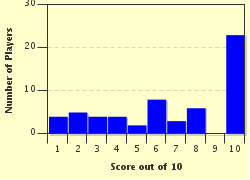Quiz Answer Key and Fun Facts
1. 4 Route du Champ d'Entraînement, Paris, France
2. Banqueting House, Palace of Whitehall, London
3. Bosworth Field, Leicestershire, England
4. Buckingham Palace, London
5. Burgh by Sands, Cumbria, England
6. Château de Saint-Germain-en-Laye, France
7. The New Forest, England
8. Newark Castle, Nottinghamshire, England
9. Osborne House, Isle of Wight, England
10. The Tower of London, London
Source: Author
Fifiona81
This quiz was reviewed by FunTrivia editor
bloomsby before going online.
Any errors found in FunTrivia content are routinely corrected through our feedback system.


